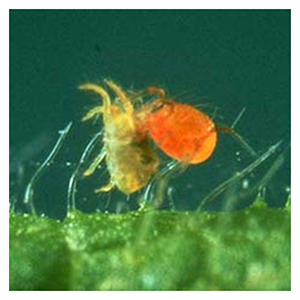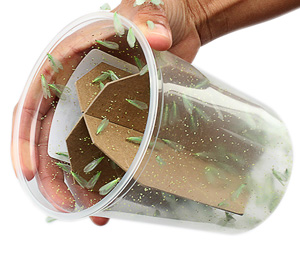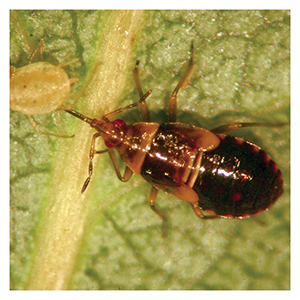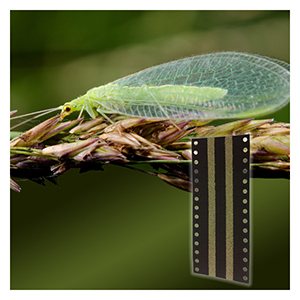Early season shipments will take the longest to hatch - up to 6 weeks. Be patient, keep egg cases warm and check often.
A Fantastic Addition To The Garden Or As A Science Project!
Praying mantids eat a wide variety of pest insects, mites, and insect eggs. Mantis egg cases are commonly released by gardeners looking for general garden pest control without chemicals. They can be instrumental in beginning biological control as part of an integrated pest management program. Young mantids prey upon smaller soft-bodied insects, while adults graduate to larger pests.
How Long Do Praying Mantis Egg Cases Take To Hatch?
Hatching requires at least 10 to 15 days of continuous warm weather (75-80°F, >50% RH) and can take as long as 6 weeks to begin. Once hatching begins, the young mantids emerge looking for something to eat. It takes just a few hours for an egg sack to complete hatching once it begins. Mantids prefer temperatures above 60°F for continued activity in the release area.
How Many Praying Mantids Are In One Egg Case?
Each praying mantis egg case, called ootheca, is collected in the wild and contains between 50–200 individual eggs.
How Many Egg Cases Should I Get?
We recommend using 3 cases every 5,000 sq. ft. or 10-100 cases per acre. It is important to space out each egg case to limit cannibalism rates among newly hatched mantids.
Disclaimer: ARBICO Organics cannot guarantee hatch rates of praying mantid egg cases because they are collected in the wild during the early spring months. We recommend hatching praying mantid egg cases in resealable containers that allow for monitoring; however, cannibalism among mantids increases when they are hatched out and kept in confined environments with limited food sources. Please release immediately after hatching commences for best results. See the "Instructions" tab for more information on hatching mantis egg cases.
This Product Controls These Pests or Diseases: Aphids, Beetles, Caterpillars, Flies, Grasshoppers, Leafhoppers, Mosquitoes
In order for Praying Mantid egg cases to hatch, they need to be kept at a temperature of 60-80°F. Hatching can take between 2-6 weeks to occur. We recommend indoor hatching so that you can monitor the hatching process. We have found that on top of a refrigerator is a good spot to store them. To slow hatching, you can keep them in their vials in the crisper section of the refrigerator.
How To Hatch Mantis Egg Cases Indoors:
- Egg cases will need to be kept tightly closed in a container until they hatch. Either leave them in the vial they arrive in, or place them in a jar (like a pickle jar) with a tight fitting lid. There is plenty of air in mason jars for the egg cases to remain viable. Do not use a plastic bag to hatch mantids.
- To monitor hatching on individual cases, place only one egg case per container. Otherwise, you can use a larger jar and put multiples inside.
- Observe closely and often. The emerging mantids will need to be released as soon as they start hatching or they will begin to eat each other.
- Once you see the hatching, take them to your desired release area and sprinkle them out. You can leave the egg case outside in the event that there are still some mantids inside waiting to hatch.
Environment: Outdoors, Vegetable Gardens, HoopHouses, Orchards & Vineyards, Greenhouse, Aquaponics
Storage: Store in a refrigerated environment until hatching is desired. If not releasing immediately, keep in a cool dark place out of direct sunlight. May be refrigerated for several weeks before release. Do not freeze. Optimal conditions for hatching are 60° to 80°F.
2025: Orders are shipped in the order they are received. No future dated shipments at this time.
Praying Mantid Egg Cases are shipped via USPS by default. You may select expedited shipping methods at checkout.
Please account for local environmental conditions in your release area when ordering.
Cannot Be Shipped To: HI,PR,VI,GU,AS,PW
What's In The Package: Each egg case (ootheca) contains between 50-200 developing mantids. May contain a small number of Carolina mantis (Stagmomantis carolina) oothecas.
Want to Learn More: Read More from our Dig Deeper Blog:
It's Ootheca Time
5 Cool Things About Praying Mantids
Mantids - So Much More Than Most People Think
Let's Talk Praying Mantids (or is it "Praying Mantises"?).
Reviews
Write a reviewSUGGESTED PRODUCTS:
-
$23.00–$85.00
-
$50.00–$180.00
-
$53.00–$154.00
-
$30.00–$100.00
-
$23.00–$85.00









